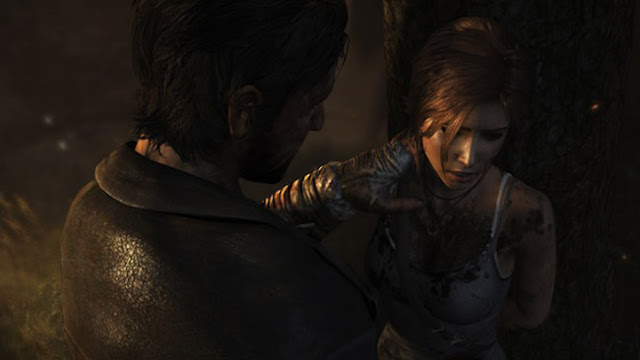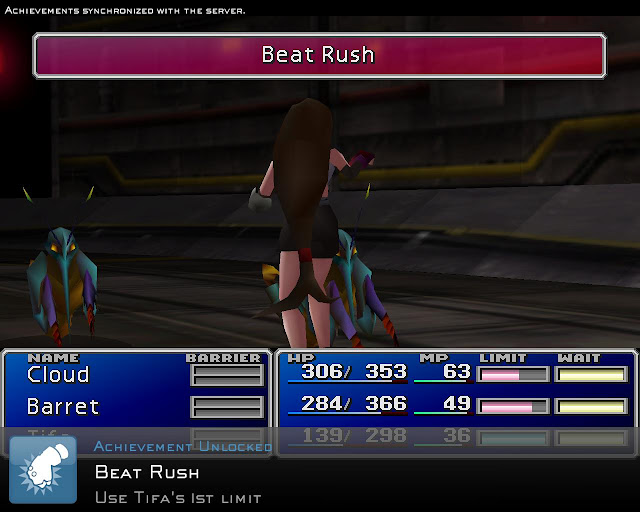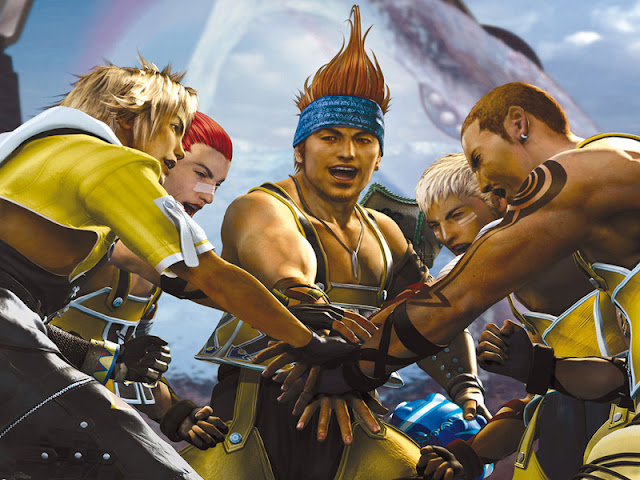When I heard that
Final Fantasy VII was being re-mastered and released on the PC earlier this year, I wondered if it would playing it through properly for the first time and documenting it in blog form.
![]() |
| The Final Fantasy VII title screen. |
I've been thinking of doing a written "
Let's Play" for a while, because "Let's Plays" are a cross between travel writing and game criticism. I'd never do a recorded, spoken-word "Let's Play" for reasons that will be clear to anyone who've heard my aborted attempts at podcasting, but writing one will, I hope, be fun. I did think about starting a new blog for the purpose, but then I'd have to update it regularly, and I don't really have time for that alongside Well-Rendered. This
Final Fantasy VII playthrough on Well-Rendered will be updated whenever I have time, so don't be surprised if it takes well over a year.
I think it's an interesting game for me to write about because unlike many gamers of my generation, I never played it when it was released in 1997. I'll therefore be looking at it fairly objectively, without the nostalgia that colours my
Tomb Raider ramblings. Before I started playing it, I wondered how much of the reverence towards the game was to do with nostalgia and how much was to do with actual merit. I reckon other people probably wonder the same thing, so hopefully they will appreciate this viewpoint.
For those who
did play it when it came out, I hope this retrospective brings back some memories.
When you start the game, there are some splash screens, and some evocative music.
![]() |
| The SquareSoft logo, complete with chocobos. |
The one thing this blog really can't get across is the music, which is utterly brilliant considering the limitations of the tools composer Nobuo Uematsu had to work with. Actually, some of my very favourite game soundtracks were from the Gameboy
Donkey Kong Land series. The composers had to be so incredibly good since they had to come up with a chiptune that was pleasant to listen to for hours on end.
Donkey Kong Land 3 had some classics ("
Cascade Capers" is pretty hectic), but the original
Donkey Kong Land probably had the best tracks.
"Track Attack" was so good that I just used to ride around on the little rotating platform for ages just listening to it. I had more time when I was 10.
The music's a good touchstone in this case because I was finally prompted to start writing this after listening to
Random (Mega Ran) and Lost Perception's
Black Materia album, a really well-researched, deftly-written hip-hop version of the
Final Fantasy VII soundtrack. The lyrics are better than pretty much anything Tim Rice ever came up with.
Speaking of Tim Rice, I saw him once. I was about seven, in a car park in Cornwall with my mum, and she saw him in his car and said "look, that's Tim Rice!" and he drove off. We weren't going to talk to him or anything, she was just pointing him out to me because I knew all the words to
Joseph and the Amazing Technicolour Dreamcoat. All of them. Even the ones to the song where they list all the colours of the coat. Anyway, Tim Rice clearly thought he was going to have to talk to a member of the public because you could hear the tyres squeal as he escaped the car park. His loss. My mum's cool!
![]() |
| Starry night. |
Once you select "New Game", there's a long, wordless sequence where you see nothing but a sky full of stars. The significance becomes clear much later, but the length of the shot really makes the game feel epic very early on. It lets you know that you'll be in this for the long haul.
![]() |
| How do you get lift like that at the roots? |
The first character you see is a girl at an altar. Character design is important, and her high collar, neck bow and softly-coloured clothes mean she has an aura of innocence and mystery. This is because in JRPG-land, especially in PSOne graphic days, any character without a miniskirt and/or an enormous cleavage exudes an aura of mystery. "Who is this strange woman, and why can I not see her breasts?".
The camera pans out, and that's the last we see of this mysteriously-dressed character for a while.
![]() |
| Midgar city streets. |
The Midgar streets are rendered in a palette of toxic yellows and grimey greys, and the continuing camera pan shows us why.
![]() |
| Midgar's Mako reactor. |
Industrial pollution, huh? Guess we're in for a story about corrupt corporations and morally-ambiguous eco-terrorists...
![]() |
| This is before steampunk was cool. I mean really cool. Before you could buy goggles in Claire's Accessories. |
And here they are. The camera pans back in as a hefty train pulls into a station. The guards in red let us know civil liberties are lacking.
![]() |
| Eco-terrorists? |
That's probably why these guys are beating them up. I really love the way this entire sequence is a single camera shot, there's no cuts. This was managed because the backgrounds are (I think) FMVs, while the moving characters are rendered separately, on top of the backdrop. It makes you feel part of the action, right from the beginning. The alternative - cut-scenes separate from gameplay - would have a dislocating effect.
![]() |
| Guess that's me. |
Ok, what's the worst that can happen?
![]() |
| What is that thing on the left? |
The first battle in the game! This is the first time we see our hero's enormous sword (steady now), which, together with his spiky hair, has become synonymous with JRPG protagonist design ever since. When
Final Fantasy VII was first released, graphics weren't that powerful, so the characters had exaggerated physical characteristics to distinguish them from each other and make their animations clear. Thus, Cloud has a vast sword and incredibly pointy hair.
You'll also notice that the first time we see him on the train platform, Cloud is
super deformed, with a large head and a tiny body, again, to make him easier to see against the game's backdrops. In the battle screens (above), there's less going on, so he can be drawn in a more realistic style.
You'll be happy to know, since I plan to play this entire game, that I managed to win that first battle without too much trouble.
![]() |
| "Achievement unlocked"? And there I was thinking I was just sitting around playing video games... |
Ooh, look at that, an achievement. I guess, along with shiny HD graphics, that's a good reason for playing the PC, rather than the PlayStation 3 version. Whether I care about achievements or trophies absolutely depends on the game I'm playing. The new
Tomb Raider games, I love getting trophies for, especially the timed runs in
Legend and
Anniversary. Likewise the kill counts with certain weapons in
Uncharted.
But some, I'm just not that bothered about. If
Final Fantasy VII continues to give me achievements for just turning up to class and not falling asleep, like it just did, I'm probably not going to get too excited.
Also, my name seems to be "EX-SOLDIER". Wonder if we can do any better than that? Guess we'll find out in a minute.
But first, time for some exposition.
![]() |
| Thanks, exposition monitor. |
Ok, this tells us a lot. Firstly, that I used to be in some kind of hardcore organisation, and secondly, that members of said organisation don't tend to socialise with the kind of people who just beat up all those guards at the train station. Since all these AVALANCHE members are dressed differently from each other, it's safe to assume that they're the good guys. Bad guys, like Storm Troopers, are always dressed the same.
Speaking of Storm Troopers, two of the three AVALANCHE members in the above screenshot are called Biggs and Wedge, like the X-Wing team who attack the Death Star at the end of
Star Wars Episode IV: A New Hope. I'm pretty sure that given the similarities between AVALANCHE and the rebels, and the fact that both teams try to destroy some major hardware owned by an evil corporation/empire, that the similarity is deliberate.
Speaking of names, what's mine?
![]() |
| "Fuzzybutt"? |
Nowadays, very few games let you name the main characters. It was a standard in the 90s, especially in Japanese games. I had
The Legend of Zelda: Link's Awakening on the GameBoy, and when I got asked for my name, I wrote "MARY", which meant that whenever anyone talked to Link in the game, they addressed "MARY", which was incredibly off-putting. It's partly because Link's a boy (not that you could really tell going by the graphics alone, the character was about 10 pixels high) and partly because it's hard to pretend you're the only survivor of a mysterious shipwreck exploring the uncharted dungeons of Koholint Island when people keep saying "Hello Mary" at you.
Having learned from that experience, I stuck with "Cloud". Many protagonists in
Final Fantasy games are named after some kind of bad weather condition, like Cloud, Squall, Lightning and even Tidus. It's a nice touch.
What about the guy with the gun?
![]() |
| Nice flat-top, dude. |
Barret looks a lot like Mr. T.
![]() |
| Barret takes over the role of Chief Exposition Officer. |
Now, I'm not an experienced eco-terrorist or what have you, but I feel that Barret should have explained this kind of thing to Cloud
before they set off to blow up the Mako reactor. And wouldn't Cloud know about Mako energy already?
The exposition continues in the lift, with Barret reassuring the player that if they're not on the side of good, they're at least on the side with good intentions.
![]() |
| What's with Jessie's mouth? |
Who could fail to be moved by that?
![]() |
| Such a cynic. |
Wow, me, I guess. Cloud here takes a rather Han Solo-ish attitude to the proceedings. After he says this, there's a pretty funny animation where Barret starts shaking to show how angry he is, but it doesn't really come across in a screenshot, so you'll have to imagine it.
![]() |
| Inside the facility. |
It's unusual for games to throw you in somewhere this bleak right at the start. Most games tend to warm you up and give you a bit of motivation by using the characters and the world to show you what you're trying to save, but
Final Fantasy VII puts you straight into a nasty decaying industrial reactor with an apparently heartless protagonist.
The environments are really excellent. Limitations really do breed creativity, and although
Final Fantasy VII's graphics were advanced for 1997, they're still fairly limited by today's standards: they must be static, for example, and there's certainly no physics. However, they're beautifully detailed, and due to restraint in their design (missing from later, big-budget iterations of the series), they're believable, too.
![]() |
| Safety first. |
Cloud delves deeper into the facility.
![]() |
| "Do not turn this valve." |
That seemed a bit easier than getting to the middle of the Death Star. When you turn the valve this happens:
![]() |
| That doesn't sound good. |
This is the first boss battle in the game, and we meet it about five minutes in. It seems like a pretty scary thing to have lurking in an industrial facility, but I guess it shows that we're definitely up against the bad guys.
It doesn't look like Cloud's MASSIVE sword is going to be enough on its own. Thank heavens we've got Barrett with us!
![]() |
| Big Shot |
Another achievement, this time for using Barret's "Limit". Limits are
Final Fantasy VII's version of a JRPG staple, a special attack that charges over time, under conditions that can in some games be set by the player. They make fights more interesting, as you have to use a little strategy to decide when you're going to deploy them.
Barret, as you might have noticed, has a gun welded on to his arm, not unlike the
Deus Ex: Human Revolution character Lawrence Barrett, also published by Square Enix. Eidos Montreal, developers of
Deus Ex: Human Revolution, assure us it's a co-incidence.
I like Barret's arm gun, it's dark, scary and threatening, especially in a character who is meant to be on your side. What kind of a world is this where dudes like this are running around blowing up reactors? It's a great bit of wordless narrative.
![]() |
| Bye bye. |
In this game, when enemies die, they go all red and transparent, and then disappear. Guess that's the final boss down, and we can get out of here. Right?
![]() |
| This is not the final countdown. There are a lot of countdowns in this game. |
I guess not. It looks like we only have eight minutes and 29 seconds before the Mako reactor explodes. We'd better get out of here!
![]() |
| The Mako reactor explodes. |
Wow. That looks pretty major. You'll have to wait until the next instalment of the Well-Rendered
Final Fantasy VII Playthrough to find out if Cloud, Barret, Biggs, Jessie and Wedge made it out alive...
All screenshots taken using FRAPS. 






































































































